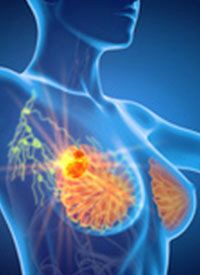Atezolizumab Does Not Improve pCR in HER2-Positive Early Breast Cancer
Adding atezolizumab to neoadjuvant standard of care therapy for HER2-positive early breast cancer did not result in a better pathologic complete response compared with placebo, according to findings from the phase 3 IMpassion050 trial.

Adding atezolizumab (Tecentriq) to neoadjuvant standard of care therapy for HER2-positive early breast cancer (EBC) did not result in a better pathologic complete response (pCR) compared with placebo, according to findings from the phase 3 IMpassion050 trial (NCT03726879).1
At the February 5, 2021, clinical cut-off, the pCR rate in the experimental arm was 62.4% vs 62.7% with placebo (difference, –0.33%; 95% CI, –9.23-8.57; P = .9551). Similarly, the pCR rate was lower with atezolizumab for patients with PD–L1-positive tumors (64.2% vs 72.5%; difference, –8.26%; 95% CI, –20.56-4.04; P = .1846). In patients with PD-L1–negative tumors, the pCR rate was 60.7% with atezolizumab compared with 53.8% with placebo (difference, 6.90%; 95% CI, –5.69-19.49).
Investigators added that the results were consistent across age, race, tumor and nodal staging, and biomarkers including central HER2, hormone receptor, and PIK3CA mutational status.
“Preclinical data provide a strong rationale for combining cancer immunotherapy with HER2-targeted therapy in HER2-positive breast cancer,” investigators wrote. “The lack of pCR improvement with atezolizumab in IMpassion050 is surprising, given the expected greater benefit of cancer immunotherapy in EBC compared with the advanced setting, because of a lower tumor burden, reduced immune escape mechanisms, and a more efficient immune system in patients with EBC.
“Current neoadjuvant standard of care for HER2-positive EBC (pertuzumab [Perjeta]-trastuzumab [Herceptin] and chemotherapy) remains valid.”
All patients in the trial received 4 cycles of dose-dense doxorubicin and cyclophosphamide, followed by paclitaxel plus pertuzumab and trastuzumab in combination. Investigators then randomly assigned patients to 840 mg of atezolizumab (n = 226) or placebo (n = 228) every 2 weeks for 4 cycles. Patients with residual disease at surgery could switch to 3.6 mg/kg of ado-trastuzumab emtansine (Kadcyla) once every 3 weeks for 14 cycles while still receiving atezolizumab or placebo.
Adults with a primary tumor greater than 2 cm and histologically confirmed, positive lymph node status, ECOG performance status of 0 or 1, and a left ventricular ejection fraction of 55% or greater were eligible for the trial. Key exclusion criteria included prior history of invasive BC,
stage IV BC, prior systemic therapy for BC, or prior treatment with anthracyclines or taxanes for any malignancy.
The coprimary end points were pCR rates in the intent-to-treat and PD-L1–positive populations. Secondary end points included pCR in patients with PD-L1–negative tumors, event-free survival (EFS), and safety.
The median age was 50.0 years in both treatment arms. Approximately 90% of patients in both groups were younger than 65 years. Women made up more than 99% of both cohorts.
Roughly two-thirds of patients in both groups were White. Asians made up 28.9% of the placebo arm and 27.4% of the experimental arm. In the placebo arm, 94.3% of patients had an ECOG score of 0 compared with 95.1% in the experimental arm.
Patients with PD-L1–stained tumor-infiltrating immune cells covering 1% or more of the tumor area were deemed PD-L1 positive. More than half (52.2%) of patients in the placebo arm were PD-L1 negative and 47.8% were positive. Those numbers were 51.3% and 48.7%, respectively, in the atezolizumab arm.
Twelve (5.3%) patients in the atezolizumab group had an EFS event compared with 7 (3.1%) in the placebo group (P = .2084). Median EFS was not estimable in either group. Thirteen (68.4%) of 19 EFS events were disease recurrences, 5 were fatal adverse events (AEs), and 1 was death due to gastric cancer. Investigators did not observe disease progression during neoadjuvant treatment.
All 5 of the grade 5 AEs occurred in the experimental arm, 4 during the neoadjuvant phase. However, only 2 of those, 1 case each of alveolitis and septic shock, were attributed to the study treatment.
During the neoadjuvant phase, 42.2% of patients in the placebo arm experienced grade 3/4 treatment-related AEs vs 47.3% in the experimental arm. Similarly, patients in the atezolizumab arm were more likely to experience treatment-related serious AEs (15.0% vs 10.7%).
Of grade 3/4 AEs with at least a 2% difference in incidence between treatment groups, febrile neutropenia (5.3% vs 1.3%), decreased neutrophil count (10.2% vs 8.0%), and decreased white blood cell count (4.0% vs 1.8%) were more common with atezolizumab. Grade 3/4 neutropenia (18.2% vs 15.9%) was more common with placebo.
Among AEs of special interest with at least a 5% difference in incidence between treatment groups in the neoadjuvant phase, immune-mediated rash (36.7% vs 29.8%), immune-mediated hepatitis (diagnosis and laboratory abnormalities; 33.6% vs 29.3%), immune-mediated hepatitis (laboratory abnormalities; 32.7% vs 28.9%), and immune-mediated hypothyroidism (14.6% vs 4.0%) all were more common in the experimental arm.
Reference
- Huober J, Barrios CH, Niikura N, et al. Atezolizumab with neoadjuvant anti-human epidermal growth factor receptor 2 therapy and chemotherapy in human epidermal growth factor receptor 2-positive early breast cancer: primary results of the randomized phase III IMpassion050 trial. J Clin Oncol. Published online June 28, 2022. doi:10.1200/JCO.21.02772



